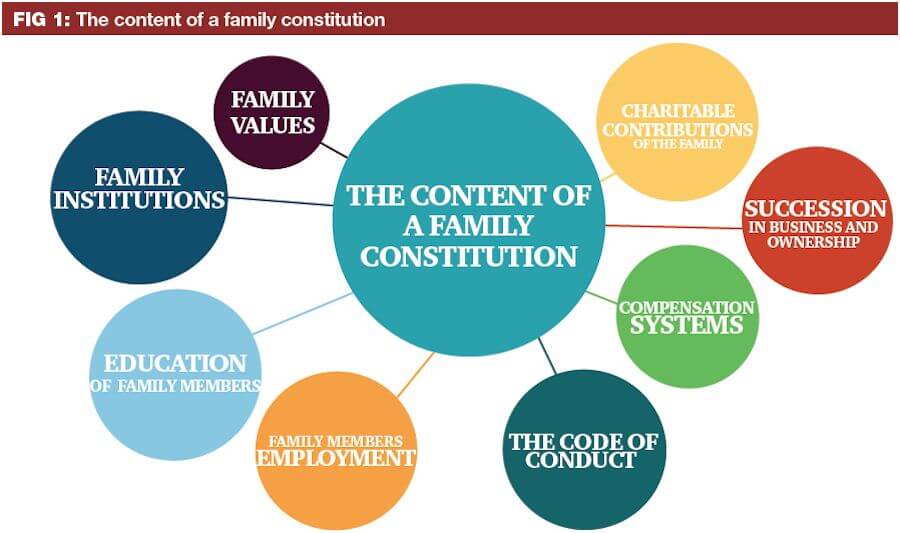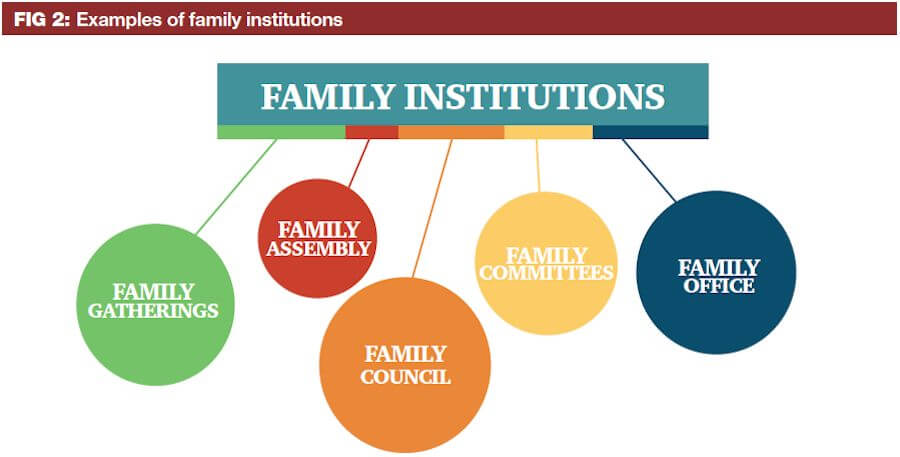QUALITY LEADERSHIP
What is Family Business Governance?
Two things are certain: Firstly, maintaining harmony in the family is difficult and secondly, running a successful business demands much hard work and discipline. In family-owned firms, those two spheres come together and force family members to constantly take decisions: Do we put family harmony before business demands? Can we take business decisions despite the potential for family conflicts?
Trying to strike a balance between family harmony and the business challenges requires constant communication and awareness. However, running a business requires much attention, and business owners are typically very absorbed in the day-to-day running of operations. In such high pressure situations, a family that still comfortably fits around the kitchen table, can hold discussions in an informal way and easily and frequently address challenges to family and business. Often first and second generations their lives in close proximity to each other and share many similar viewpoints. However, once in-laws are added to the family paradigm and the third generation grows up in various different households, maybe with slightly different values, it becomes increasingly difficult to reach easy consensus on family and business matters. Increasing numbers of family members, plurality of family branches and generations, geographical diversity, growth, and increasing complexity of the business challenge the “kitchen table model” of communication and decision-making. So how can family harmony be maintained in a way that has a positive impact on the business and lead to efficient decision-making mechanisms?
One way to address this challenge is to set down a set of rules that regulate how family members that are part of a family business interact with each other and with their business for the greater good of the family harmony and sustainability and growth of the business.
What is a family constitution?
Over the past decades the term family governance has emerged, defining the overall organisation of a family that jointly owns, and possibly manages a company. Within this structure, the written rules or principles regulating the relationship between family members and interaction with the family business have been called Family Charter, Family Creed, Family Protocol, Code of Conduct amongst many other names. For the sake of simplicity in this article, the collection of those rules will be called the “Family Constitution”.
Despite a common belief there actually is no set structure or compulsory content for a family constitution. The constitution can be one document, or a set of documents, it can be one or fifty pages long, entirely depending on the family’s preferences and requirements.
Essentially, the right family constitution is a document that reflects the family’s culture and way of life and responds to its current requirements in the most accurate, complete way and gives the family various ways to implement it.
Is the family constitution part of corporate governance?
Corporate governance is a set of rules that regulates the relationships between the stakeholders in a business with a view to reducing risk exposure and guiding the management of the corporation. Corporate governance should be implemented in businesses, whether they are family-owned or privately-owned and are a legal requirement for all public companies. The family constitution, on the other hand, presents a set of rules that regulates the interaction between family members and their impact on the business. It intersects with the corporate governance system in some areas, such as employment of family members, possibly ownership questions, and other issues such as succession planning and codes of conduct. Essentially, however, the family constitution is part of the family governance system and as such has a different basis and “raison d’être” than corporate governance rules.
What is the content of a family constitution?
The first question many families face when starting their family constitution is the question what the document should contain. With family members holding different opinions it can be a challenge to find common ground regarding the topics to address. Many families tend to cover questions of values and principles, education and employment, family institutions and ownership matters. Some families however adopt a more pragmatic approach by only covering what they know they can implement without much effort. Of course, it is every family’s decision, based on their structure, culture, and history, which approach to take and what areas to cover in their constitution. Here are the some elements recommended to be included in the document:
The family values
Often families like to start the constitution by setting down their principles and values, as well as vision for the future of the family and sometimes the business.
The family institutions and what they can do
Family constitutions often include rules on how the family can get organised in groups and committees with a view to implement the family constitution rules in everyday-life. These so called “Family Institutions” again have various names and functions and can be very different from one family to the next. Their most important feature however should be a measurable success in implementing the rules set out in the family constitution.
Education of family members
A crucial aspect of many family constitutions is the question of education and the support systems available for individual family members.
Family members employment in the business
One of the biggest challenges in family businesses with growing numbers of family members is their employment and active involvement in the business. Be it at executive level or in any other position in the business, families need to put down basic structures of how family members can apply to join the business. These rules should create a sense of fairness and equal opportunity, yet at the same time not hinder innovation and flexibility for special situations.
How should we behave? The code of conduct
The first and second generations of a family business often grow up in the same households and, therefore, tend to have similar cultural and social values. From the third generation onwards, however, the family tends to break out into different branches that can develop different views regarding values and the right behaviours. A code of conduct setting out general guidelines regulating the family’s actions in relation to the business can help overcome these differences and maintain uniformity.
What do I get out of it?
Oftentimes families use the family constitution to regulate perks and bonus systems that are given to family members in addition to salaries and/or dividends. In families with activities in consumer goods for example, the question of discounted access to those goods for family members often comes up. A fair, transparent system applicable to all family members can help anticipate conflict.
Succession in business and ownership
Some families set out basic principles for the succession of family members, who are holders of positions in the family and in the ownership structure. This is not to be confused with succession in the business, as this should ideally be regulated for family members and non-family members in the business’ corporate governance codes.
Charitable contributions of the family
Many family firms are engaged in social and philanthropic projects. In their family constitutions, family members can set standards and principles for their social engagement and formulate a broad vision.
What are family institutions?
In order to ensure that the rules of the family constitution are implemented, the family can organise groups of family members that are responsible for the realisation of certain areas of the family constitution. Such “Family Institutions” can have a variety of names and each family can define their functions according to their own requirements and needs. There are several main functions that most families might eventually seek to fill:
The “Family Gathering”
Bringing together all members of the family once every year can be a great opportunity to have fun and spend time together. Such gatherings do not have to have any other function than to enforce the family ties and ensure that family members living away from each other remain close.
The “Family Assembly”
In order to take broad decisions on how the family should work together all family members from a certain age onwards can gather and vote. Together they can also amend and develop the constitution or elect representatives in other family institutions. Such family assemblies can help direct the overall vision of the family and influence its relationship with the business. The family is free to decide who can attend the family institutions, who can vote and help take decisions. Each family will do this differently, and should decide attendance based on its culture and structure.
The “Family Council”
In order to implement the family constitution’s rules throughout the year many families have a smaller group of family members that gathers several times a year and is responsible for tangible results. Such a council can again have a variety of functions but will typically be in charge of implementing the rules set out by the document.
The “Family Committees”
Every family will face different challenges at different times and might find it has to give specific topics more attention. In such situations a small number of family members can be elected to handle the issue and provide solutions.
The “Family Office”
Family Offices can be helpful institutions to support the family on various levels in administrative, financial and wealth management, as well as family governance aspects. Often families employ non-family members to run such an office.
How to develop a family constitution
Writing down rules that apply to the family and define its relationship with the business can be a challenging, long, and emotional journey. The family needs to be prepared to confront underlying issues as well as open conflicts.
Common vision and buy-in
One of the most important elements is that as many family members as possible understand the importance of a family constitution, embedded in an overall coherent family governance system, and support the development of rules applicable to all family members.
Discipline
Families working together on developing a family constitution need to be aware that the process will demand a lot of discipline from every family member to develop a document that is customised and implementable. Every opinion is important in the process and needs to be recorded and discussed.
Awareness
As the process of developing a family constitution might lead to challenging discussions and the confrontation with difficult issues, family members involved in the process need to be aware of their own position, as well as respect the situation of their family members.
Delegation
In families with more than ten family members, it is normally not possible to equally involve all family members in the process of developing the content. Therefore, it is helpful to nominate a delegation composed of family members from all branches and ages to work together. It is also crucial to keep the rest of the family informed of any progress and developments in order to receive a steady flow of feedback and comments.
Typical concerns with regards to the development of a family constitution
Finally, let us list the main concerns when formulating the family constitution:
Should we include our ownership principles in my family constitution?
Some families opt to include their shareholder and ownership agreements into the family constitution. This is possible and depending on the family structure and needs might be a good idea. Shareholder agreements should be kept separate if the family business is partially owned by non-family members or if there is any intention to have non-family owners in the future. Families also need to be aware of the fact that shareholder agreements are legally binding structures that at best need to be drafted and approved by legal professionals.
Is the Family Constitution legally binding?
The legal nature of family constitutions strongly depends on the laws and regulations the document is developed under. It is best to consult a lawyer once or twice during the development of the family constitution to understand the legal framework and which parts of the document would eventually be legally binding.
Should we regulate our Family Office in the Family Constitution
This depends on the individual structure of the family business. Often, families set out the principle that they will have a family office, and that this family office will have certain functions. In families where the Family Office has a primarily wealth management and investment function, it is advised to regulate the details of the Office in a separate set of regulations, which should be in line with the legal requirements of an investment office or wealth management entity.
The big question: Implementing the Family Constitution
Often the process of writing the family constitution is perceived as the most difficult process – endless debates on content and structure, votes and meetings with advisors demand a lot of time and energy. However, it is the implementation of the constitution that will be real test for a family, as it will show if the document is realistic, if it suits the family’s culture and if the family is ready to continue the work. Family governance is a never ending project, and the improvement it can bring depends for the most part on how its rules and regulations can be implemented.
Even though writing a Family Constitution can be a challenging process, it can turn into one of the most motivating, enriching and interesting projects for a family. Never throughout the process should family members forget that together they can create great opportunities for themselves and generations to come.
Tharawat Magazine, Issue 18, 2013







